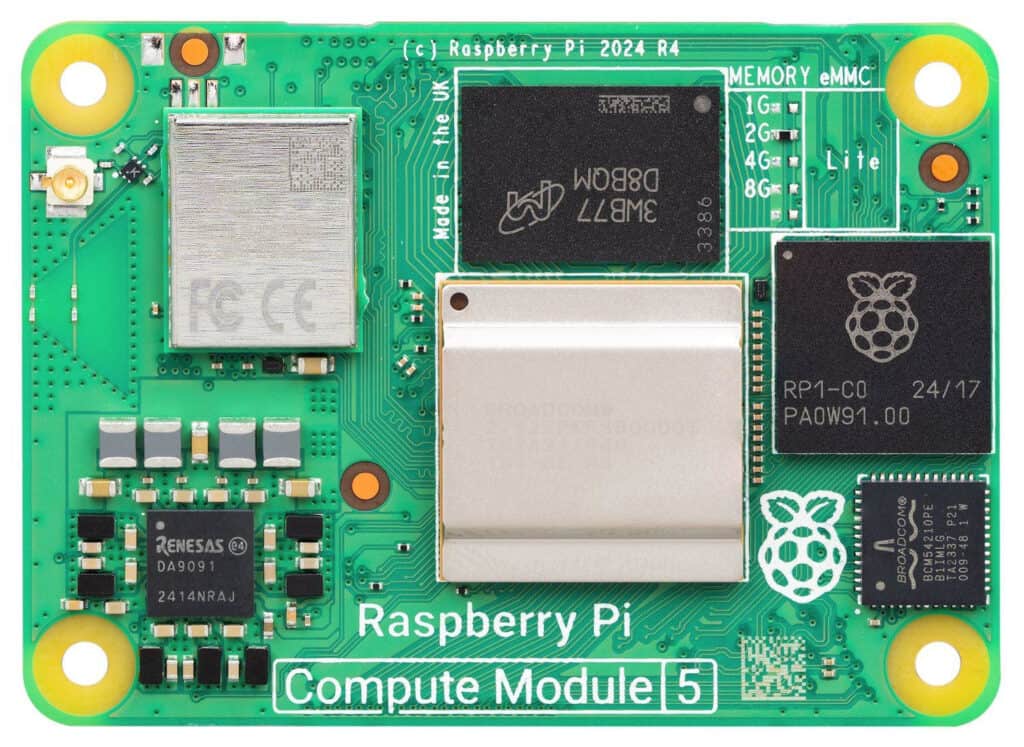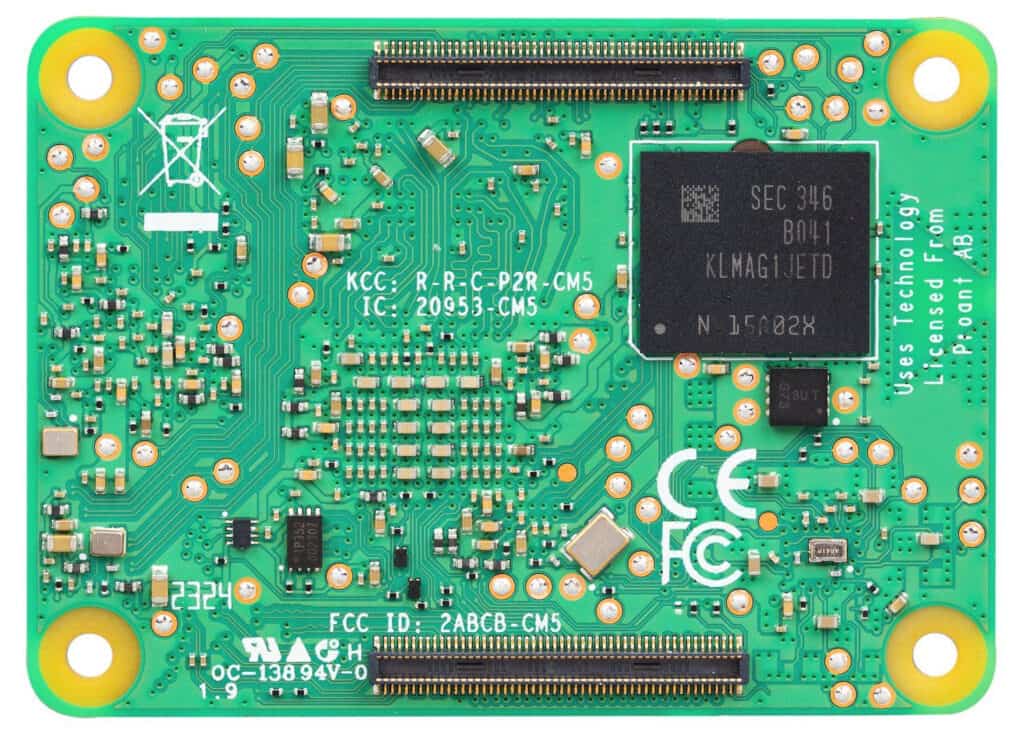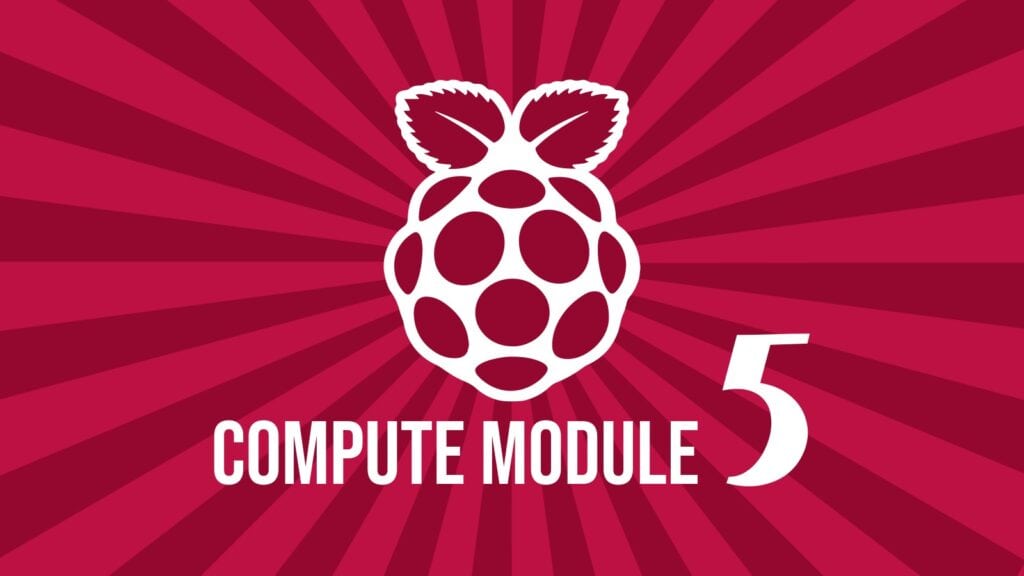The world of embedded computing has just gotten an exciting new upgrade. Introducing the brand-new Raspberry Pi Compute Module 5, a versatile system-on-module (SoM) that packages the Raspberry Pi 5’s powerful capabilities in a format specifically designed for embedded applications.
This new offering, starting at just $45, delivers flexibility, performance, and a smooth development experience for a wide range of custom applications.
The Compute Module 5’s core is a quad-core Arm Cortex-A76 processor clocked at 2.4GHz. The module is designed for use in various environments, from industrial automation to home-built projects.
You can choose from multiple configurations: RAM options include 2GB, 4GB, or 8GB LPDDR4-4267 SDRAM, and storage options range from 0GB (Lite) to 64GB eMMC flash memory.
The Compute Module 5 comes in several versions to match different project needs and budget considerations. Here’s a quick look at the different configurations and price points:
- 2GB RAM, 0GB eMMC (Lite): $45
- 2GB RAM, 16GB eMMC: $50
- 4GB RAM, 0GB eMMC (Lite): $55
- 4GB RAM, 64GB eMMC: $70
- 8GB RAM, 0GB eMMC (Lite): $75
- 8GB RAM, 64GB eMMC: $90
For those needing wireless capability, the configurations are available at a slightly higher price, starting at $50 for the 2GB RAM Lite version.


Below is the full specifications table for the new device:
| SOC Type | Broadcom BCM2712 |
| Core Type | Quad-core 64-bit Arm Cortex-A76 (Armv8) SoC @ 2.4GHz |
| Memory Options | 1GB, 2GB, 4GB, 8GB LPDDR4-4267 SDRAM with ECC 0GB, 16GB, 32GB, or 64GB eMMC flash memory |
| Wi-Fi & Bluetooth | 2.4 GHz, 5.0 GHz IEEE 802.11 b/g/n/ac wireless Bluetooth 5.0, BLE |
| Ethernet | Gigabit Ethernet PHY supporting IEEE 1588 |
| Ports | 1 × PCIe x1 root complex, Gen 2 (5Gbps) 1 × USB 2.0 port (high speed) 2 × USB 3.0 ports, supporting simultaneous 5Gbps operation 2 × HDMI 2.0 ports (supports up to 4Kp60 on both ports simultaneously) 2 × 4-lane MIPI ports supporting both DSI (display port) and CSI-2 (camera port) |
| GPIO | Up to 30 × GPIO supporting either 1.8V or 3.3V signalling and peripheral options: Up to 5 × UART Up to 5 × I2C Up to 5 × SPI 1 × SDIO interface 1 × DPI (parallel RGB display) 1 × I2S Up to 4 × PWM channels Up to 3 × GPCLK outputs |
| Multimedia | 4Kp60 HEVC decoder OpenGL ES 3.1 graphics, Vulkan 1.2 |
| Form Factor | 55 mm × 40 mm × 4.7 mm module |
For product designers, the available development kit makes prototyping straightforward. It includes all the essential components: a Compute Module 5, an IO Board, a power supply, an antenna kit, and more. It’s truly an all-in-one package to jump-start your embedded solutions.
Compared to its predecessor, the Compute Module 5 brings numerous advancements. Notably, it includes additional I/O interfaces—up to 30 GPIO pins, HDMI outputs capable of delivering dual 4Kp60 video, and multiple USB 3.0 ports—providing greater versatility in the module’s integration into custom systems.
But it’s not just about raw power; it’s also about flexibility. The module’s compatibility with various peripherals and signals means product designers can craft the ideal setup for their specific use case.
For those concerned with cost, there’s good news: the Compute Module 5 offers versions without built-in storage, allowing developers to bring their own flash solution and keep costs to a minimum.
Furthermore, Raspberry Pi has committed to keeping the Compute Module 5 in production until at least January 2034, reassuring manufacturers who require stable, long-term product availability.
Refer to the Raspberry Pi’s announcement or check out this document for more information.
